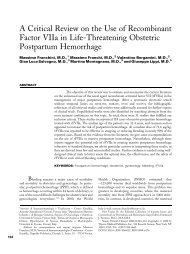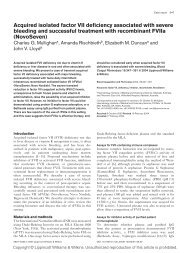Comprehensive Stroke Care : An Overview - ResearchGate
Comprehensive Stroke Care : An Overview - ResearchGate
Comprehensive Stroke Care : An Overview - ResearchGate
Create successful ePaper yourself
Turn your PDF publications into a flip-book with our unique Google optimized e-Paper software.
of disability. Whereas in unconscious patient it focuses<br />
upon prevention of contractures, in conscious patient it<br />
helps improve the functional out come.<br />
Use dependent plasticity in human brain leads to<br />
functional recovery and can be utilized through<br />
physiotherapy or biofeedback mechanisms. Active<br />
physiotherapy also protects against DVT and<br />
Pulmonary Embolism. Thus Speech therapy and<br />
physiotherapy help in early recovery of functional status.<br />
The fastest recovery occurs in early 3 months of stroke<br />
and this should be the period of maximum rehabilitation<br />
effort, though it should be continued till desired results<br />
are attained. 24 A randomised, controlled, single –blind<br />
clinical trial comparing the intervention program to<br />
usual care suggested gain in endurance, balance and<br />
mobility beyond those attributable to spontaneous<br />
recovery and usual care thus highlighting the need of<br />
rehabilitative efforts. 25<br />
After stroke, recurrence is another major problem. 21,26<br />
Oral anticoagulation treatment is a preferred choice for<br />
inferred cardioembolism in the setting of atrial<br />
fibrillation. Varying rates of hemorrhage with oral<br />
anticoagulants continue to favor antiplatelet therapy in<br />
other settings of inferred etiology.<br />
Because emergent use of an anticoagulant in<br />
ischaemic stroke is associated with significantly<br />
increased risk of hemorrhagic transformation, it is<br />
suggested that most patients with acute stroke should<br />
not be treated with unfractionated heparin or other<br />
rapidly acting anticoagulants after stroke. Prevention of<br />
deep vein thrombosis and pulmonary embolism among<br />
bedridden patients is the only established indication<br />
for early anticoagulation after acute ischaemic stroke.<br />
Chen ZM et al have recommended that “early aspirin is<br />
of benefit for a wide range of patients, and its prompt<br />
use should be routinely considered for all patients with<br />
suspected acute ischaemic stroke, mainly to reduce the<br />
Eligibility criteria for iv rt-PA thrombolysis treatment of<br />
acute ischaemic stroke<br />
Inclusion criteria<br />
Onset of symptom to drug administration time is below 3<br />
hours<br />
Patient has significant neurological deficit.<br />
No hemorrhage on CT Scan.<br />
Exclusion criteria<br />
<strong>Stroke</strong> or severe head trauma in last three months<br />
Major surgery in last 14 days<br />
Systolic BP above 185 mm of Hg or Diastolic BP above 110<br />
of mm of Hg.<br />
If patient is rapidly improving or has minor symptoms<br />
Symptoms suggest Sub Arachnoid Hemorrhage<br />
Hematuria, malena, hemoptysis with in last 21 days.<br />
Seizure at the onset of stroke<br />
Elevated PTT for patients on heparin<br />
Prothrombin Time > 15 sec.<br />
Platelet count < 100,000/ mm 2<br />
Glucose < 50 or > 400 mg/Dl.<br />
risk of early recurrence ”. 27<br />
Management of intracerebral hemorrhage<br />
Blood Pressure<br />
mean arterial pressure < 130 mm Hg in those with a history<br />
of hypertension<br />
avoid mean arterial pressure > 110 mm Hg if patient is<br />
postoperative<br />
prevent fall of systolic BP < 90 mm Hg<br />
Intracranial Pressure<br />
NO STEROID are indicated<br />
Intracranial Therapy is defined more than 20 mm of Hg for<br />
> 5 min<br />
Maintain cerebral perfusion pressure > 70 mm of Hg<br />
Osmotherapy – mannitol 20% 0.25 - 0.5 g/kg every 4 hour<br />
keeping serum osmolality goal of less than or equal to 310<br />
mOsm per decileter<br />
Hyperventilation - pCO 2<br />
30-35<br />
Muscle relaxants<br />
Non depolarizing neuromuscular blockade Volume<br />
Maintain euvolumia<br />
Temperature<br />
Treat temperatures > 38.5 C<br />
Medical Therapy<br />
Factor rVII 28,29 given within four hours after intracerebral<br />
hemorrhage<br />
Surgery<br />
For cerebellar hemorrhage > 3 cm who are deteriorating or<br />
have brain stem compression and hydrocephalus from<br />
ventricular compression<br />
Consider if hemorrhage > 10 cm, Glasgow Coma Scale > 4,<br />
young patient with moderate or large hemorrhage with<br />
clinical deterioration.<br />
Adapted from Broderick JP et al. <strong>Stroke</strong> 1999;30:905-915.<br />
Patients should be given comprehensive guidelines<br />
and choice of methodologies available for preventing<br />
the recurrence.<br />
<strong>Stroke</strong> care has future owing to the research<br />
worldwide in studying the salvageable cerebral tissue<br />
utilizing the perfusion diffusion imaging and<br />
delineation of ischaemic penumbra, augmentation of<br />
thrombolysis using sonography 30 therapeutic use of stem<br />
cells 31 etc.<br />
Hence, India must rise to the occasion. Specialized<br />
stroke management should be offered through Public<br />
Health System with active participation of government<br />
and Non government Organization. Special efforts<br />
should be taken for creating stroke awareness at<br />
community level. Community should have stroke<br />
support groups to create awareness and help in<br />
rehabilitation of the patients . Other means of information<br />
must be set up like online support groups and<br />
community seminars. Cost of the therapy should not act<br />
as a deterrent to national government as the DALYs,<br />
which the prompt therapy would cut short, would have<br />
many fold advantage for the nation which takes pride<br />
for its Human Resource. Further, stroke clinicians and<br />
scientists must actively participate into research in order<br />
to gain data and information specific to our demography<br />
© JAPI • VOL. 54 • JANUARY 2006 www.japi.org 39





